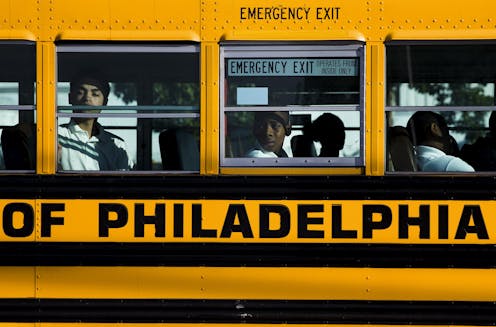
Across the United States, arrest rates for young people under age 18 have been declining for decades. However, the proportion of youth arrests associated with school incidents has increased.
According to the U.S. Department of Education, K-12 schools referred nearly 230,000 students to law enforcement during the school year that began in 2017. These referrals and the 54,321 reported school-based arrests that same year were mostly for minor misbehavior like marijuana possession, as opposed to more serious offenses like bringing a gun to school.
School-based arrests are one part of the school-to-prison pipeline, through which students – especially Black and Latine students and those with disabilities – are pushed out of their schools and into the legal system.
Getting caught up in the legal system has been linked to negative health, social and academic outcomes, as well as increased risk for future arrest.
Given these negative consequences, public agencies in states like Connecticut, New York and Pennsylvania have looked for ways to arrest fewer young people in schools. Philadelphia, in particular, has pioneered a successful effort to divert youth from the legal system.
Philadelphia Police School Diversion Program
In Philadelphia, police department leaders recognized that the city’s school district was its largest source of referrals for youth arrests. To address this issue, then-Deputy Police Commissioner Kevin Bethel developed and implemented a school-based, pre-arrest diversion initiative in partnership with the school district and the city’s department of human services. The program is called the Philadelphia Police School Diversion Program, and it officially launched in May 2014.
Mayor-elect Cherelle Parker named Bethel as her new police commissioner on Nov. 22, 2023.
Since the diversion program began, when police are called to schools in the city for offenses like marijuana possession or disorderly conduct, they cannot arrest the student involved if that student has no pending court case or a history of adjudication. In juvenile court, an adjudication is similar to a conviction in criminal court.
Instead of being arrested, the diverted student remains in school and school personnel decide how to respond to their behavior. For example, they might speak with the student, schedule a meeting with a parent or suspend the student.
A social worker from the city also contacts the student’s family to arrange a home visit, where they assess youth and family needs. Then, the social worker makes referrals to no-cost community-based services. The student and their family choose whether to attend.
Our team — the Juvenile Justice Research and Reform Lab at Drexel University — evaluated the effectiveness of the diversion program as independent researchers not affiliated with the police department or school district. We published four research articles describing various ways the diversion program affected students, schools and costs to the city.
Arrests dropped
In our evaluation of the diversion program’s first five years, we reported that the annual number of school-based arrests in Philadelphia decreased by 84%: from nearly 1,600 in the school year beginning in 2013 to just 251 arrests in the school year beginning in 2018.
Since then, school district data indicates the annual number of school-based arrests in Philadelphia has continued to decline — dropping to just 147 arrests in the school year that began in 2022. That’s a 91% reduction from the year before the program started.
We also investigated the number of serious behavioral incidents recorded in the school district in the program’s first five years. Those fell as well, suggesting that the diversion program effectively reduced school-based arrests without compromising school safety.
Additionally, data showed that city social workers successfully contacted the families of 74% of students diverted through the program during its first five years. Nearly 90% of these families accepted at least one referral to community-based programming, which includes services like academic support, job skill development and behavioral health counseling.
Fewer suspensions and expulsions
We compared data from 1,281 students diverted in the first three years of the school-based program to data from 531 similar students who were arrested in schools before the program began but who would have been eligible if the diversion program existed.
Diverted students were significantly less likely to be suspended, expelled or required to transfer to another school in the year following their school-based incident.
Long-term outcomes
To evaluate a longer follow-up period, we compared the 427 students diverted in the program’s first year to the group of 531 students arrested before the program began. Results showed arrested students were significantly more likely to be arrested again in the following five years.
Although we observed impacts on arrest outcomes, the diversion program did not appear to affect long-term educational outcomes. We looked at four years of school data and found no significant differences in suspension, dropout or on-time graduation between diverted and arrested students.
Finally, a cost-benefit analysis revealed that the program saves taxpayers millions of dollars.
Based on its success in Philadelphia, several other cities and counties across Pennsylvania have begun replicating the Police School Diversion Program. These efforts could further contribute to a nationwide movement to safely keep kids in their communities and out of the legal system.
Research reported in this article was supported by funding from the U.S. Department of Justice, Office of Justice Programs, Office of Juvenile Justice and Delinquency Prevention (2014-JZ-FX-K0003; 2017-JF-FX-0055), the National Institute of Justice (NIJ; 2017-CK-BX-0001), and the Stoneleigh Foundation. The content of this article is solely the responsibility of the authors and does not necessarily represent the views of the United States Department of Justice, its agencies, the Stoneleigh Foundation, or other funding organizations.
Naomi Goldstein receives funding from the National Institute of Justice (NIJ) and previously received funding from the NIJ,Office of Juvenile Justice and Delinquency Prevention, and Stoneleigh Foundation.
This article was originally published on The Conversation. Read the original article.







